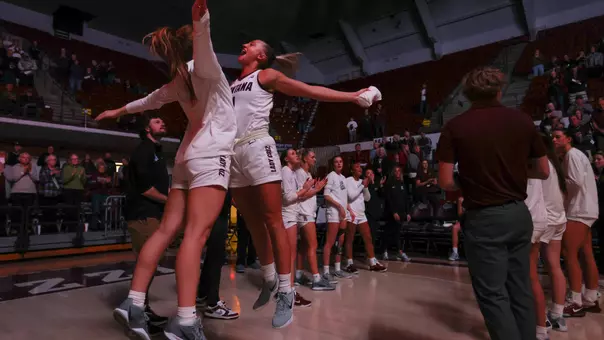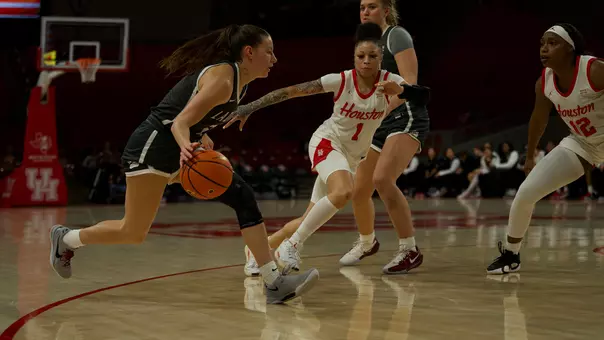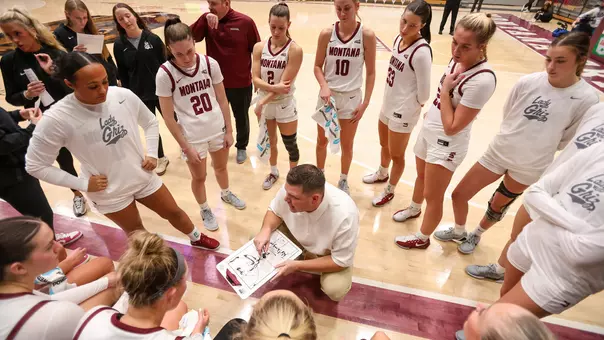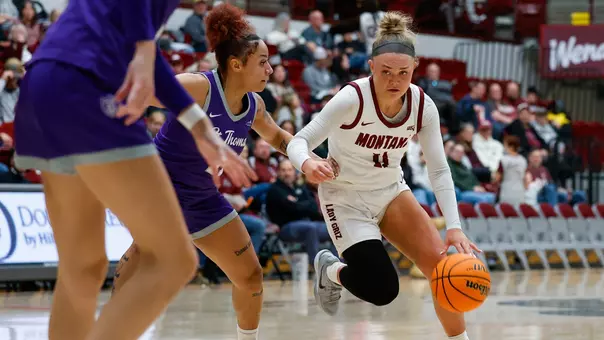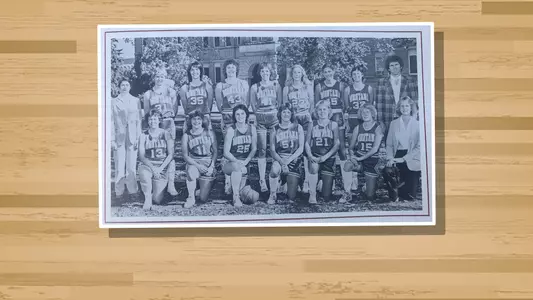
Lady Griz Rewind :: 1980-81
4/30/2020 3:30:00 PM | Women's Basketball
When the 1980-81 season opened, the Montana women's basketball team had the pieces in place to make a breakthrough.
The team had won 19 games the year before, in coach Robin Selvig's second season, and had four starters returning for his third.
Headlining that group was senior center Jill Greenfield, a second-team All-Northwest Women's Basketball League selection the year before, plus senior forward Sandy Selvig, senior guard Annette Whitaker and sophomore forward Janet Ruetten.
It would be a season marked by a number of firsts. It was the first time the team was referred to as the Lady Grizzlies and it would be the first time Montana would host a tournament in what would become a cherished annual tradition, often around the holidays.
That year the Lady Griz Insurance Classic brought in Iowa, BYU and Washington for an early-January tournament, which would be won by the Huskies after they outscored Montana 40-31 in the second half to rally for a 64-59 victory in the championship game.
Another first: The game drew a crowd of 1,239, the first time Montana cracked the 1,000 mark for a game that was not a doubleheader with the men.
Something else that was new: The team left the region for the first time in program history and headed to the Bay Area for a pre-Christmas, three-game visit to California.
That trip gave rise to a story that defined where Montana was headed: a 22-win season and the start of what would be an 18-year run of consecutive 20-win campaigns. Often to the surprise of the unsuspecting.
People would come to know the Lady Griz and what they represented but that December the team descended upon the Bay Area as an unknown.
The Stanford players wouldn't have been able read about Montana's trip-opening 74-51 win at Saint Mary's the day before that improved the Lady Griz to 7-1 on the season.
They wouldn't have known Greenfield would finish the season averaging a double-double, 16.1 points, 10.6 rebounds, or that Montana would limit its opponents that season to 55.5 points on 35.1 percent shooting.
The Cardinal players, who had already played games that season against UCLA, Arizona and Washington, had just one question for the Lady Griz before the game.
"I remember their girls asking a couple of our girls if we were Division I," recalls Selvig. "Maybe that wasn't that weird of a question at the time, but I remember our girls not being happy with the question."
Those were heady times in California. The state's governor -- Ronald Reagan -- had been elected president the month before and would be inaugurated in Washington DC on January 20, 1981, exactly one month after the Lady Griz and Cardinal squared off in front of a crowd of 144 in Palo Alto.
Greenfield had 22 points and 13 rebounds and Montana ("In those days we would have been four to a room on a trip like that," said Selvig) won 65-49 to improve to 8-1 and announce that, yes, these Lady Griz were not only Division I but not one to be taken lightly.
Another key to the victory was freshman guard Cheri Bratt's then season-high 12 points, four rebounds and four assists with no turnovers.
In her dreams, Bratt, who was from Kalispell, would have been living in California that season, as a member of the UCLA Bruins.
Her parents were from Fort Benton and had close ties with the family of Denise Curry, who was raised in Fort Benton before the family moved to Davis, Calif., prior to the start of Curry's high school career.
Curry would enroll at UCLA prior to the 1977-78 season and go on to score 3,198 points over four years, still the top total in Bruins history.
Curry scored 803 points as a sophomore -- 23.6 points per game -- when UCLA was winning 24 times and playing host to Bratt and her family, who traveled to Southern California for a vacation that doubled as a sales trip, with the high school junior doing the self-selling.
"We visited with them and the coach, went to a couple games," says Bratt, now Cheri Roberts, a registered dietician at Community Medical Center in Missoula. "They wouldn't have known about me. The recruiting wasn't like it is now, of course.
"I was interested in UCLA, Oregon, Washington State. I wanted to go (Pac-10) and go out of state. Those schools were interested but once my knee went out, none of them would offer me any money."
That happened midway through her senior season at Flathead High.
"I can remember it pretty vividly. We were in Bozeman. I remember coming down, dribbling and making a two-foot jump stop and it just went out, like an ACL does," she says.
An ACL tear, surgery and recovery was anything but routine in that era. Find the wrong doctor and the injury could be a career limiter at best, a career ender at worst.
Luckily the family had another connection, this time to Dr. Ron Losee, who had been practicing in Ennis since 1949 and had used his inquisitive nature and a steady stream of athletes from Bozeman, Butte and Helena with "loose knees" (as they were known) to become a pioneer in ACL repair.
His first ACL operation was performed in 1971. There was no standard protocol to follow at that time, just knowledge, experience and maybe a hunch or two. "Neither one of us really was sure that an operation would work," he would later write in his autobiography about himself and his first patient.
"I was just one of the (doctors in the nation at that time) who was having fun figuring it out."
That family connection got Bratt in to see Doc Losee on a Sunday, shortly after her injury. She would play on her injured knee at the state tournament but it wouldn't last a game. She had surgery in January (in the days when girls' basketball was a fall sport in Montana).
Today an ACL patient will begin physical therapy hours after getting out of surgery. Back in 1980, Bratt was sent home with a plaster cast that went ankle to hip and would immobilize her leg for eight weeks.
Then it was eight more weeks in a brace that also covered the length of her leg.
Whatever the good doctor had done -- Bratt was patient No. 125 to have her knee fixed by Doc Losee -- he nailed it.
"We had no physical therapy, nothing like we do now, but once it was fixed, it was good," says Roberts. "I had surgery in January and was going full steam by September. God was willing and watching over me.
"There was talk of wearing a brace, but he said, If your knee is going to go out again, it's going to go out. All the brace is going to do is give you emotional support. I didn't wear a brace, and my knee didn't really bother me the rest of my career. There is a big, old scar, but it's sure held together."
But those schools on her dream list? They were gone, unless she was willing to pay her own way. And even then, a roster spot wasn't a guarantee.
"Rob was the only one that stuck with me and was willing to take a chance on me," says Roberts.
She would reward that belief. As a freshman Bratt averaged 8.6 points, 5.7 rebounds and 4.3 assists. Her 129 assists and 95 steals in 1980-81 both established new program records.
The season opened with easy home wins over Carroll and Great Falls, then a 74-62 road win at Weber State, with Greenfield going for 29 points on 13-of-17 shooting and 12 rebounds.
"It was nice to come into the program and have a big person already well established," says Roberts, mother of Olivia Roberts, who would be the Mountain West Conference MVP in 2017-18 at Wyoming. "She was really fun to play with.
"She was a really good player. She was tall and had a really nice shooting touch. For a big girl, she was mobile and had a really nice shot."
The fourth game of the season would produce the first loss, an ugly 63-62 setback at Utah State that had 60 turnovers and 47 fouls called.
Selvig would get a technical, one of his five that season.
"That was probably down from the years before when I used to get a few T's," said Selvig. "I seem to recall I got quite a few in those early years.
"Never got kicked out of a game. Of course it took three T's those days."
Montana would shoot 60 percent in an 82-55 home win over Gonzaga and add home wins over Idaho State and Northern Montana before heading to California.
At the time, it wasn't Stanford that was the highlight of the road trip. It was the third and final game, against San Francisco, which had gone 28-5 the year before and won a Northern California Athletic Conference championship under coach Walt Bugler.
The Dons were ranked as high as No. 19 nationally that season.
Bugler started the USF program in 1976-77, giving him a two-year head-start on Selvig.
"I got a phone call one morning saying, 'We're going to start a women's basketball program and we'd like you to come start it for us. We have no money, we have no budget, we can't pay you.
"I said, Why not?" recalled Bugler last year, on his induction into the San Francisco Hall of Fame.
His full-time job at the time was in the construction business. He would step down after the 1979-80 season, still earning less than $5,000 for his coaching job.
Jan Ternyik would replace Bugler prior to the 1980-81 season and the Dons would continue winning, going 22-8.
One of those wins came against Montana, 61-50, three days before Christmas. Mary Hile, who would later coach the team for 19 seasons, from 1987-88 to 2005-06, had 17 points and 16 rebounds.
She would finish her career with 2,324 points and 1,602 rebounds, and three times was named a Kodak all-region player.
And she was probably a big reason Selvig picked up technical No. 2 on the season. It didn't help that there were only 110 fans in attendance. Selvig's voice and intensity in a quiet gym only would have been amplified.
"He was so ferocious on the bench those years. He was a bit of a hothead. He's mellowed over the years," jokes Roberts.
"People would always say, How can you play for that guy? He's like a maniac. I had to tell them, no, he's not really like that. He's not like that in the locker room or off the court. It didn't bother us. It usually fired us up because we knew how much it meant to him."
Montana would open the new year by hosting the Lady Griz Insurance Classic. On opening day, Montana knocked off Iowa and Washington defeated BYU.
The tournament would live on for decades.
"It was a way to get teams into Missoula and build a schedule. There were people in the community who wanted to help do that," says Selvig, hinting at what would be the start of Copper Connection, a support organization that continues to this day.
Montana answered its five-point loss to Washington in the championship game with five straight wins, including a 3-0 start to NWBL play with victories over Washington State, Eastern Washington (Greenfield: 30 points, 16 rebounds) and Boise State.
Montana would follow the win at Boise State with a 59-52 loss at Idaho State, a game in which the Lady Griz would attempt just three free throws. Technical: Selvig.
The game was also notable because Montana would win its next 37 games against Idaho State, stretching two full decades, to the 2000-01 season.
Montana, at 9-3 in league, would win the Mountain Division of the NWBL in 1980-81, topping Montana State (5-7), Eastern Washington (4-8), Washington State (4-8) and Boise State (3-9).
The Coast Division was top heavy with Oregon, under coach Elwin Heiny, and Oregon State, under coach Aki Hill. Montana would go 0-10 against those two teams in Selvig's first four seasons at Montana.
The two teams swept Montana in Missoula in early February, both teams winning behind big performances from their stars.
Bev Smith, who would play for Canada in three Olympics and was the NWBL Player of the Year as a sophomore, junior and senior, led the Ducks to an 89-57 victory in a game that was four points at the half before Oregon outscored Montana 53-25 in the second half. (Technical, Selvig? You know it.)
Smith finished with 38 points on 14-of-19 shooting, 11 rebounds, seven assists and three steals. "She was the best player in Oregon history for a long, long time," says Selvig.
It was the most points scored against Montana until Wake Forest's Dearica Hamby put up 40 on the Lady Griz in November 2014 in Mexico.
"Oh yeah, I remember her," says Roberts. "Very physical. Short, blond hair. Just a beast at that time. I was just a freshman and totally intimidated by her."
Two days later Carol Menken, all 77 inches of her, had 26 points, 14 rebounds, four assists, four blocks and four steals as the Beavers won 77-69.
"She was 6-5 and really good," said Selvig. "She was just a tough matchup for everybody. She was 6-5 and good, and that was a problem trying to guard her."
That would drop Montana to 3-3 in league, but the Lady Griz would respond with six straight wins to end the regular season and claim the Mountain Division.
That included a late sweep of Montana State.
Montana wrapped up the regular season with an 80-70 overtime home win over the Bobcats, with Bratt nearly posting a triple-double, with 12 points, 10 rebounds and nine assists. And six steals.
"She was a really good player for sure. It wasn't a surprise. I thought she was going to be a great player, but you didn't know about the knee," says Selvig. "Those days there were questions, but that didn't bother me a bit."
Montana would host the AIAW Region IX Playoffs but would get knocked off in its first game, 72-54 by Oregon State, which shot 53.8 percent in the first half to jump out to a 40-26 halftime lead.
Menken had 32 points. She went 11 for 13 from the field, 10 for 14 from the line.
Oregon State (which went 9-2 in league) would knock off Oregon (a perfect 11-0 in league) 61-54 the next day in the region championship game. Both teams would advance to the AIAW national tournament.
Montana defeated Washington 56-45 in the third-place game, with Greenfield going for 19 points and 15 rebounds in her final game as a Lady Griz.
Montana held Washington to 26.2 percent shooting and forced the Huskies into 24 turnovers.
Greenfield, voted all-region after the season, led Montana in scoring and rebounding in 1980-81. The next two leading scorers were both freshmen, Doris Deden (9.8/g) and Bratt (8.6/g).
Deden shot 53.4 percent that season to set a new program record. Bratt set her own records in assists and steals, signaling even bigger things ahead.
"We were pretty good defensively that year and had a couple freshmen who really helped," said Selvig. "We definitely had some good wins."
Shannon Green, a freshman from Big Sandy, played in 17 of 30 games that season. She got in for two minutes in Montana's loss to Oregon State.
It would her final time taking the court for the Lady Griz. She would die the following August from injuries sustained in a late-night, one-vehicle rollover near her hometown.
"It was really tragic," said Selvig. "Someone dies who was part of your team and part of your life. A terrible thing."
When the 1981-82 season rolled around the next fall, Montana would open practice without a senior but with three returning starters (Bratt, Deden, Ruetten) and an incoming class that had Selvig saying it "could easily be the best I've had here."
Stay tuned.
The team had won 19 games the year before, in coach Robin Selvig's second season, and had four starters returning for his third.
Headlining that group was senior center Jill Greenfield, a second-team All-Northwest Women's Basketball League selection the year before, plus senior forward Sandy Selvig, senior guard Annette Whitaker and sophomore forward Janet Ruetten.
It would be a season marked by a number of firsts. It was the first time the team was referred to as the Lady Grizzlies and it would be the first time Montana would host a tournament in what would become a cherished annual tradition, often around the holidays.
That year the Lady Griz Insurance Classic brought in Iowa, BYU and Washington for an early-January tournament, which would be won by the Huskies after they outscored Montana 40-31 in the second half to rally for a 64-59 victory in the championship game.
Another first: The game drew a crowd of 1,239, the first time Montana cracked the 1,000 mark for a game that was not a doubleheader with the men.
Something else that was new: The team left the region for the first time in program history and headed to the Bay Area for a pre-Christmas, three-game visit to California.
That trip gave rise to a story that defined where Montana was headed: a 22-win season and the start of what would be an 18-year run of consecutive 20-win campaigns. Often to the surprise of the unsuspecting.
People would come to know the Lady Griz and what they represented but that December the team descended upon the Bay Area as an unknown.
The Stanford players wouldn't have been able read about Montana's trip-opening 74-51 win at Saint Mary's the day before that improved the Lady Griz to 7-1 on the season.
They wouldn't have known Greenfield would finish the season averaging a double-double, 16.1 points, 10.6 rebounds, or that Montana would limit its opponents that season to 55.5 points on 35.1 percent shooting.
The Cardinal players, who had already played games that season against UCLA, Arizona and Washington, had just one question for the Lady Griz before the game.
"I remember their girls asking a couple of our girls if we were Division I," recalls Selvig. "Maybe that wasn't that weird of a question at the time, but I remember our girls not being happy with the question."
Those were heady times in California. The state's governor -- Ronald Reagan -- had been elected president the month before and would be inaugurated in Washington DC on January 20, 1981, exactly one month after the Lady Griz and Cardinal squared off in front of a crowd of 144 in Palo Alto.
Greenfield had 22 points and 13 rebounds and Montana ("In those days we would have been four to a room on a trip like that," said Selvig) won 65-49 to improve to 8-1 and announce that, yes, these Lady Griz were not only Division I but not one to be taken lightly.
Another key to the victory was freshman guard Cheri Bratt's then season-high 12 points, four rebounds and four assists with no turnovers.
In her dreams, Bratt, who was from Kalispell, would have been living in California that season, as a member of the UCLA Bruins.
Her parents were from Fort Benton and had close ties with the family of Denise Curry, who was raised in Fort Benton before the family moved to Davis, Calif., prior to the start of Curry's high school career.
Curry would enroll at UCLA prior to the 1977-78 season and go on to score 3,198 points over four years, still the top total in Bruins history.
Curry scored 803 points as a sophomore -- 23.6 points per game -- when UCLA was winning 24 times and playing host to Bratt and her family, who traveled to Southern California for a vacation that doubled as a sales trip, with the high school junior doing the self-selling.
"We visited with them and the coach, went to a couple games," says Bratt, now Cheri Roberts, a registered dietician at Community Medical Center in Missoula. "They wouldn't have known about me. The recruiting wasn't like it is now, of course.
"I was interested in UCLA, Oregon, Washington State. I wanted to go (Pac-10) and go out of state. Those schools were interested but once my knee went out, none of them would offer me any money."
That happened midway through her senior season at Flathead High.
"I can remember it pretty vividly. We were in Bozeman. I remember coming down, dribbling and making a two-foot jump stop and it just went out, like an ACL does," she says.
An ACL tear, surgery and recovery was anything but routine in that era. Find the wrong doctor and the injury could be a career limiter at best, a career ender at worst.
Luckily the family had another connection, this time to Dr. Ron Losee, who had been practicing in Ennis since 1949 and had used his inquisitive nature and a steady stream of athletes from Bozeman, Butte and Helena with "loose knees" (as they were known) to become a pioneer in ACL repair.
His first ACL operation was performed in 1971. There was no standard protocol to follow at that time, just knowledge, experience and maybe a hunch or two. "Neither one of us really was sure that an operation would work," he would later write in his autobiography about himself and his first patient.
"I was just one of the (doctors in the nation at that time) who was having fun figuring it out."
That family connection got Bratt in to see Doc Losee on a Sunday, shortly after her injury. She would play on her injured knee at the state tournament but it wouldn't last a game. She had surgery in January (in the days when girls' basketball was a fall sport in Montana).
Today an ACL patient will begin physical therapy hours after getting out of surgery. Back in 1980, Bratt was sent home with a plaster cast that went ankle to hip and would immobilize her leg for eight weeks.
Then it was eight more weeks in a brace that also covered the length of her leg.
Whatever the good doctor had done -- Bratt was patient No. 125 to have her knee fixed by Doc Losee -- he nailed it.
"We had no physical therapy, nothing like we do now, but once it was fixed, it was good," says Roberts. "I had surgery in January and was going full steam by September. God was willing and watching over me.
"There was talk of wearing a brace, but he said, If your knee is going to go out again, it's going to go out. All the brace is going to do is give you emotional support. I didn't wear a brace, and my knee didn't really bother me the rest of my career. There is a big, old scar, but it's sure held together."
But those schools on her dream list? They were gone, unless she was willing to pay her own way. And even then, a roster spot wasn't a guarantee.
"Rob was the only one that stuck with me and was willing to take a chance on me," says Roberts.
She would reward that belief. As a freshman Bratt averaged 8.6 points, 5.7 rebounds and 4.3 assists. Her 129 assists and 95 steals in 1980-81 both established new program records.
The season opened with easy home wins over Carroll and Great Falls, then a 74-62 road win at Weber State, with Greenfield going for 29 points on 13-of-17 shooting and 12 rebounds.
"It was nice to come into the program and have a big person already well established," says Roberts, mother of Olivia Roberts, who would be the Mountain West Conference MVP in 2017-18 at Wyoming. "She was really fun to play with.
"She was a really good player. She was tall and had a really nice shooting touch. For a big girl, she was mobile and had a really nice shot."
The fourth game of the season would produce the first loss, an ugly 63-62 setback at Utah State that had 60 turnovers and 47 fouls called.
Selvig would get a technical, one of his five that season.
"That was probably down from the years before when I used to get a few T's," said Selvig. "I seem to recall I got quite a few in those early years.
"Never got kicked out of a game. Of course it took three T's those days."
Montana would shoot 60 percent in an 82-55 home win over Gonzaga and add home wins over Idaho State and Northern Montana before heading to California.
At the time, it wasn't Stanford that was the highlight of the road trip. It was the third and final game, against San Francisco, which had gone 28-5 the year before and won a Northern California Athletic Conference championship under coach Walt Bugler.
The Dons were ranked as high as No. 19 nationally that season.
Bugler started the USF program in 1976-77, giving him a two-year head-start on Selvig.
"I got a phone call one morning saying, 'We're going to start a women's basketball program and we'd like you to come start it for us. We have no money, we have no budget, we can't pay you.
"I said, Why not?" recalled Bugler last year, on his induction into the San Francisco Hall of Fame.
His full-time job at the time was in the construction business. He would step down after the 1979-80 season, still earning less than $5,000 for his coaching job.
Jan Ternyik would replace Bugler prior to the 1980-81 season and the Dons would continue winning, going 22-8.
One of those wins came against Montana, 61-50, three days before Christmas. Mary Hile, who would later coach the team for 19 seasons, from 1987-88 to 2005-06, had 17 points and 16 rebounds.
She would finish her career with 2,324 points and 1,602 rebounds, and three times was named a Kodak all-region player.
And she was probably a big reason Selvig picked up technical No. 2 on the season. It didn't help that there were only 110 fans in attendance. Selvig's voice and intensity in a quiet gym only would have been amplified.
"He was so ferocious on the bench those years. He was a bit of a hothead. He's mellowed over the years," jokes Roberts.
"People would always say, How can you play for that guy? He's like a maniac. I had to tell them, no, he's not really like that. He's not like that in the locker room or off the court. It didn't bother us. It usually fired us up because we knew how much it meant to him."
Montana would open the new year by hosting the Lady Griz Insurance Classic. On opening day, Montana knocked off Iowa and Washington defeated BYU.
The tournament would live on for decades.
"It was a way to get teams into Missoula and build a schedule. There were people in the community who wanted to help do that," says Selvig, hinting at what would be the start of Copper Connection, a support organization that continues to this day.
Montana answered its five-point loss to Washington in the championship game with five straight wins, including a 3-0 start to NWBL play with victories over Washington State, Eastern Washington (Greenfield: 30 points, 16 rebounds) and Boise State.
Montana would follow the win at Boise State with a 59-52 loss at Idaho State, a game in which the Lady Griz would attempt just three free throws. Technical: Selvig.
The game was also notable because Montana would win its next 37 games against Idaho State, stretching two full decades, to the 2000-01 season.
Montana, at 9-3 in league, would win the Mountain Division of the NWBL in 1980-81, topping Montana State (5-7), Eastern Washington (4-8), Washington State (4-8) and Boise State (3-9).
The Coast Division was top heavy with Oregon, under coach Elwin Heiny, and Oregon State, under coach Aki Hill. Montana would go 0-10 against those two teams in Selvig's first four seasons at Montana.
The two teams swept Montana in Missoula in early February, both teams winning behind big performances from their stars.
Bev Smith, who would play for Canada in three Olympics and was the NWBL Player of the Year as a sophomore, junior and senior, led the Ducks to an 89-57 victory in a game that was four points at the half before Oregon outscored Montana 53-25 in the second half. (Technical, Selvig? You know it.)
Smith finished with 38 points on 14-of-19 shooting, 11 rebounds, seven assists and three steals. "She was the best player in Oregon history for a long, long time," says Selvig.
It was the most points scored against Montana until Wake Forest's Dearica Hamby put up 40 on the Lady Griz in November 2014 in Mexico.
"Oh yeah, I remember her," says Roberts. "Very physical. Short, blond hair. Just a beast at that time. I was just a freshman and totally intimidated by her."
Two days later Carol Menken, all 77 inches of her, had 26 points, 14 rebounds, four assists, four blocks and four steals as the Beavers won 77-69.
"She was 6-5 and really good," said Selvig. "She was just a tough matchup for everybody. She was 6-5 and good, and that was a problem trying to guard her."
That would drop Montana to 3-3 in league, but the Lady Griz would respond with six straight wins to end the regular season and claim the Mountain Division.
That included a late sweep of Montana State.
Montana wrapped up the regular season with an 80-70 overtime home win over the Bobcats, with Bratt nearly posting a triple-double, with 12 points, 10 rebounds and nine assists. And six steals.
"She was a really good player for sure. It wasn't a surprise. I thought she was going to be a great player, but you didn't know about the knee," says Selvig. "Those days there were questions, but that didn't bother me a bit."
Montana would host the AIAW Region IX Playoffs but would get knocked off in its first game, 72-54 by Oregon State, which shot 53.8 percent in the first half to jump out to a 40-26 halftime lead.
Menken had 32 points. She went 11 for 13 from the field, 10 for 14 from the line.
Oregon State (which went 9-2 in league) would knock off Oregon (a perfect 11-0 in league) 61-54 the next day in the region championship game. Both teams would advance to the AIAW national tournament.
Montana defeated Washington 56-45 in the third-place game, with Greenfield going for 19 points and 15 rebounds in her final game as a Lady Griz.
Montana held Washington to 26.2 percent shooting and forced the Huskies into 24 turnovers.
Greenfield, voted all-region after the season, led Montana in scoring and rebounding in 1980-81. The next two leading scorers were both freshmen, Doris Deden (9.8/g) and Bratt (8.6/g).
Deden shot 53.4 percent that season to set a new program record. Bratt set her own records in assists and steals, signaling even bigger things ahead.
"We were pretty good defensively that year and had a couple freshmen who really helped," said Selvig. "We definitely had some good wins."
Shannon Green, a freshman from Big Sandy, played in 17 of 30 games that season. She got in for two minutes in Montana's loss to Oregon State.
It would her final time taking the court for the Lady Griz. She would die the following August from injuries sustained in a late-night, one-vehicle rollover near her hometown.
"It was really tragic," said Selvig. "Someone dies who was part of your team and part of your life. A terrible thing."
When the 1981-82 season rolled around the next fall, Montana would open practice without a senior but with three returning starters (Bratt, Deden, Ruetten) and an incoming class that had Selvig saying it "could easily be the best I've had here."
Stay tuned.
1995 National Champions: 30-Year Anniversary
Wednesday, December 17
Griz Football vs. Montana State Juicer - 11/20/25
Wednesday, December 17
Griz Football Postgame Press Conference vs. South Dakota State - 12/6/25
Wednesday, December 17
Griz Football's Eli Gillman Offensive Player of the Year Highlights
Wednesday, December 17

